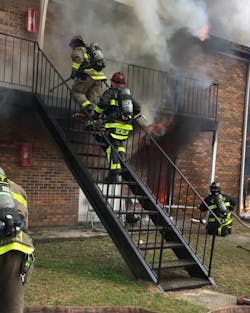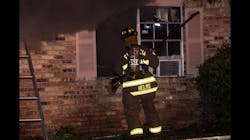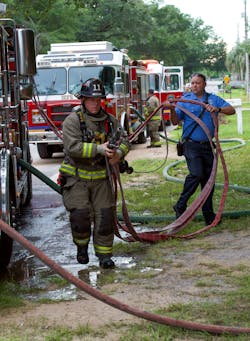Command & Control Success: People Before Water
We have been taught for decades that the initial fireground incident priorities are life safety, property conservation and incident stabilization. Placing people before water shows a deeper understanding of putting life safety before property conservation in the strategic thought process of the fireground commander, which drives the initial tactics that arriving companies take. However, the historical order of tactics that are taken to accomplish fire attack, primary search and a sustained water supply needs a closer look.
First, this look requires firefighters, company officers and, particularly, fireground commanders to solidly understand the capabilities of the onboard water supply of assigned engine companies. This pertains to the size, occupancy and fire location in the building, combined with the amount of fire. Of course, fast water and a sustainable water supply are critical to the overall mission. However, this shouldn’t be prioritized over life safety rescue operations.
Second, to prioritize saving both life and property through fire attack, you must understand the hose and the nozzle package that are on your apparatus, particularly the individual attack line flow rates. This understanding drives how much fire that you can extinguish with the water application rate of the line size that’s selected and how long that your tank water will last while flowing (timing your tank).
Historically, the fire service has taught that the second-due engine company establishes a water supply by laying a supply line from a hydrant to the fire. It seems that many areas throughout the country perform this the majority of the time by completing a forward lay: It’s as if the reverse lay hasn’t been taught or is considered taboo. A forward lay for a supply line from the hydrant removes a firefighter from the equation of supporting the booster tank attack and/or supporting fast water on the fire. It also means that fewer firefighters are available to start the initial primary search in the first five minutes of arrival.
In today’s fire service, most departments operate single-company stations; firehouses that have dual companies almost are nonexistent except in major metropolitan cities that use fully staffed engine and ladder companies.
The majority of departments staff their companies with two, three or, hopefully, four firefighters. Arriving on scene on one apparatus with no more than four firefighters limits the speed of getting water on the fire and, more importantly, delays the start of a primary search.
Chief Brian Brush recently finished a survey/research project on civilian rescues at fires that are performed by firefighters. The data that were collected and the results that were produced by Brush and the Firefighter Rescue Survey indicate that firefighters rescue an average of 10 civilians per day from fires. Most rescues occur in private dwellings and apartment buildings. The research, along with nearly 2,000 rescue surveys that were completed on firefighterrescuesurvey.com, provides data on the importance of a rapid-fire attack, supported by a rapid primary search operation in the first 5–7 minutes after arrival. To complete fire attack and search operations in a basic private dwelling in fewer than 7 minutes takes at least six firefighters who maximize tank water “fast water.” Therefore, it is vital that you get water on the fire and you remove trapped occupants more quickly than ever before based on modern building construction and furnishings.
By combining rescue data, the results of UL Fire Safety Research Institute research regarding types of fire attack (including coordinated fire attack) and understanding of the modern fire environment, you must put people before water—and forgo the strategy and tactics of yesterday. Yes, use your experience to create strong tactics that put out fires, but you must be open to modifying your strategy and tactics based on a change in response times, staffing and fire behavior. People’s lives depend on fast water.
Please note that I, as a fireground commander, fully support and want a continuous water supply from a hydrant at every fire. However, it just might not be established by the first or even the second apparatus. A large portion of the fire service needs firefighters more than water in the first 5–7 minutes. Remember, you have to be using water to need water, and it takes firefighters to properly stretch and operate an attack line using water. It takes even more firefighters to push into a building properly and to get the hoseline past different pinch points. Once the line has made it to its final room of fire, some firefighters who are staffing the line can go from an attack search to a fully committed search.
Given the fact that a fire flow of 150 gpm, or 2.5 gallons per second, is the fire service’s most commonly accepted application rate for private dwellings, a 750-gallon booster tank can flow continuously for five minutes. We frequently reference that the first five minutes of a fire is when most life-saving tactics are carried out. Water application is a life-saving tactic that directly supports search and rescue operations. We know that fire growth is exponential through science and experience, and, conversely, we know that victim survivability declines exponentially.
The data from the Firefighter Rescue Survey show that when the primary attack team or search team located victims, the victims have an 88 percent survival rate if they were found in the first four minutes and a 77 percent survival rate if they were found in the first six minutes. The data confirm what I experienced in the streets over the past 30 years: Fireground tactics that utilize onboard tank water to get fast water on the fire—supported with proper staffing, so enough firefighters arrive on the fireground early enough to initiate a fire attack and a primary search or VES simultaneously—are successful.
As far as the aforementioned tank, flow rate and flow time of a 750-gallon booster tank, let’s take that tank and back it up with another tank of water from the second-arriving engine, or what I call the booster backup. (Some call it the force multiplier.) This fireground tactic puts people before water. When doing this, you go from 750 gallons to 1,500 gallons of fast water available without delay. It brings two companies of firefighters straight to the scene, provides 10 minutes of sustainable flow at the aforementioned flow rate and, most importantly, provides an additional company of firefighters on scene in the first 5–7 minutes (depending on your department response times) to maximize the completion of several fireground tasks. These tasks include the fast attack to get water on the fire quickly, force entry, push in with the attack line, search for victims, and, possibly, vent if the fire and smoke conditions dictate that venting is a positive tactic based on a tactically intelligent decision and on understanding coordinated fire attack.
To drive the booster backup tactic, one must look at the survey data, today’s fire behavior, UL studies and, most importantly, our experiences to put people before water. Yes, a sustained water supply is critical, but is it more critical than if your family or neighbors were trapped in a private dwelling that has just one or even a couple of rooms of fire? We tell citizens who we protect that they should close their doors at night before they go to bed, but are we getting there with enough fast water and staffing and using the proper tactics that will maximize the rescue of trapped occupants? It’s time that we take a long, hard look at what our booster tanks, or fast water tanks, truly can extinguish.
Third due for supply
We must evaluate the concept of laying a supply line when a single company that has no more than four firefighters is on scene of a private dwelling fire that has a high probability of trapped occupants. Sometimes, the second company must respond directly into the scene to provide additional staffing, so people’s lives are prioritized above a supply line. You can and will save more lives if you truly can understand: the extinguishment capabilities of tank water; your staffing levels and maximizing the capabilities of the first two companies working together to get a line in the house; putting water on the fire; tactically ventilating; and quickly searching for and removing trapped occupants.
When you place people before water, you must understand the importance of filling in the remaining tactical assignments to companies that are on the box. One such assignment is what I refer to as third due for supply: the third-due engine secures a hydrant water supply, to ensure a positive, sustained water supply. I prefer this to be a reverse lay, if possible, to allow everyone other than the apparatus driver to report straight to the scene. The driver reverses out and places the engine on the hydrant for maximum water supply capabilities. This allows the driver to engage the pump and send water to the scene.
Tactics put out fires.
Curt Isakson will present “Command Success” at Firehouse Expo. To register, visit firehouseexpo.com.
About the Author

Curt Isakson
Curt “Ike” Isakson is a 30-plus-year veteran of the fire service. He worked for Escambia County, FL, Fire Rescue for 25 years. Isakson previously worked nine years for the Pensacola, FL, Fire Department, where he was assigned as a company officer on Heavy Rescue 31. His fire service experience started at a young age as a junior firefighter with the Midway, FL, Fire District; he rose through the ranks to captain. Isakson's identification of the need for a series of special-interest fire conferences spawned the development of County Fire Tactics, which covers officer development, command officers, water on fire, high-rise operations, and leadership and tactics.


